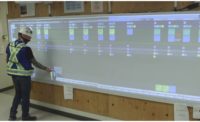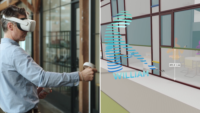In late 2019, the building team behind Carilion Roanoke Memorial Hospital in Roanoke, Va., didn’t know that virtual reality mock-ups that users could walk through with a headset would be key to its $300-million hospital expansion project.
At the time, the hospital board was asking Robins & Morton to construct traditional physical mock-ups of patient rooms and operating rooms so that doctors, nurses and other hospital personnel could tell project managers exactly what they needed to do their jobs.
"They had grand ideas at the beginning that we put price tags to," says Bill Stevens, senior superintendent at Robins & Morton, "and the physical mock-ups were quite costly. So, I recommended some VR options. Initially, a lot of people were somewhat resistant to it, but I said, 'let's do it to supplement the actual mock-ups.' And we did the first iteration and about half of the team just fell in love with it."
After the COVID-19 pandemic made traveling and meeting impossible for the Nashville-based design team of Earl Swensson & Associates (ESa), several of Robins & Morton's project team members from throughout the southeast and even hospital personnel, the VR mock-ups that were delivered by Chicago-based VDC consultant VIATechnik became critical to the project.
“It became a much better solution because not only could you use the VR headset, but we could view images through a computer, and the designer was able to take it and explain the rooms to the users,” Stevens says.
Michael Fontana, VR specialist and Sr. VDC engineer at VIATechnik, says that while Robins & Morton had done VR mock-ups before, these had to be able to fully replace physical mock-ups. The experience had to be real enough that hospital staff could recommend changes to headwalls and other placements just from seeing the environment in Unreal Engine.
"I knew that the conventional practice of throwing a raw construction model into a standard visualization tool would not suffice. It needed to be more realistic and believable," says Steve Moore, manager of scheduling and innovative support at Robins & Morton.
In late spring 2020, Moore's interactions with VIATechnik were also hampered by the pandemic. Moore was working from a treehouse office in his backyard in Birmingham, Ala., unable to go to the office and sharing work-from-home space with family.
"I asked VIATechnik to send me a sample of their work and I fired it up in a VR headset in my treehouse," he recalls. "I was instantly transported to Union Station in Chicago. I could hear the ambiance in 3D spatial sound. The textures, lighting, and shadows were very realistic. Even the train schedule and ATM screens were functional. I felt like I was there and could reach out and touch my surroundings. The flooring had realistic flaws and stains."
To represent Carilion Roanoke's ORs and patient rooms, ESa provided design files mostly in Revit, while Robins & Morton sent everything from shop drawings to drone flights recording the angles of daylight shining into patient-room windows. VIATechnik took that data and put it into the visual-effects software Autodesk Maya to create the detailed environment, then loaded it into Unreal Engine for VR viewing by project stakeholders.
“It’s the traditional workflow that’s used outside of AEC,” says Anton Dybuncio, COO of VIATechnik. “AEC professionals use 3D, it’s built for building, but then the video game industry has more flexibility, and you can create better details in there. Maya is very good at producing very fine detail, combined with Unreal Engine that's very visually powerful."
Moore says VIATechnik took data from a thousand cut sheets and modeled every single piece of equipment in the rooms to the design model's exact specifications, including colors and textures. ESa's designers sat in on many review sessions with Robins & Morton's team to iron out finite design details prior to presenting the mock-ups to the client. The high-fidelity mockup required a higher level of detail from the design team that ESa met.
"If you look closely at the outlets on the walls, you can even see faint smudge marks from people’s fingers," Moore says.
The original, pre-pandemic plan was to use the VR mock-ups to reduce rework on future physical mock-ups. After a few design reviews and iterations, the physical mock-up scope shrank smaller and smaller until cost savings roughly 13 times the cost of investment in the technology were realized by eliminating them entirely, while yielding the full benefit of the physical mock-up process.
The expansion is on schedule for completion in 2024.
Carilion Roanoke Hospital executives told Robins & Morton that the VR mock-ups are detailed enough to replace any need for physical ones in the future. Robins & Morton plans to expand its use of VR and AR mock-ups on heath care projects even when pandemic-related travel restrictions are lifted.





Post a comment to this article
Report Abusive Comment